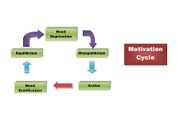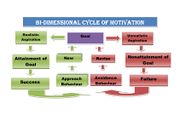Introduction
|
|
It is beyond doubt that motivation facilitate persons to achieve success in their life. A strong urge to perform would yield to success even if a person is not capable enough to perform an intended action.
In order to understand this let us examine this ficticious stroy. A family, consisting of husband, wife and a months baby, is travelling in a car and unfortunately met with an accident. The family was scattered and gone to unconsiousness. The first person to get consciousness is the wife. She immediately saw her months baby about to crush under the wheels of the car. On seeing it she immediately gone to the car and lifted the car to save the baby. She has no physical strength to lift the car but has strength of motivation. This is power of motivation.
Overview
|
In these days of competetion, every parent wants their children, especially at PU level, to achieve good grades in their curricular subjects for a better and successful life. This intense feelings of parents would necessitate a PU lecturer to motivate their students to achieve better grades in their examinations. However, getting higher achievement depends on the intensity and directionality of motivation of a student. As a matter of fact motivation has intensity and direction. Intensity depends on the strength of needs and interests. These needs would provide a direction to ones action as all actions are need based. Intensity of motivation increases when there is a strong urge to do an action.
|
Objectives
|
After going through the sections mentioned above and completing the activities suggested, you would be able to;
- The concept of motivation and techniques of motivation
- Enhance your skills in using techniques of motivation to enhance higher achievements among your students
- Understand the contexts under which these techniques could be used
|
|
Why this Module?
|
| Generating a strong urge to achieve a goal would forces an individual to get into intesified goal directed action(s). Generating a strong urge to achieve a goal would forces an individual to get into intesified goal directed action(s). In order to motivate students to improve their achievement levels it is then necessary to intensify their urge to enhance their actions specifically directed to higher goals. However, action intensifies when the goal is within the limits students' potential and the set goal is realistic. Large gap between the goal and potential (goal discrepency) may force the students to withdraw their actions. Hence, the goal descrepency need to be at optimal level. Optimal levels may vary from individual to individual and vary from context to context. This module focuses on such vital issues of motivating students to improve their achievement levels. In this module several techniques of motivating students will be discussed to help PU lecturers in using them.
|
What is Motivation?
|
Motivation is a very common word with too many meanings associated to it. Basically it is a process that leads an individual to specific goal directed actions. The genesis of any actions is need/urge that create an imbalance within the organism. This is called as need deprivation and this prepares organism to get into such actions that would gratify the need. Need gratification helps the organism to resotre balance/equilibrium. As one need is gratified another need might create disequilibrium and puts organism into another action to maintain balance. This means that motivation is a continuous/cyclic process as there no chance where organism is in a state of needlessness. Need deprivation is a state normally called as motivated behaviour. The major principle of motivation is the tendency of motivated behaviour to maintain balance within the organism. This tendency is technically called as 'Homeostasis'. Actually need deprivation puts organism into a physiological state that drives towards a goal (need that is deprived). These physiological states of need deprivation are called as 'Drives'. For example the hunger is the drive consequent to need for food, thirst is the drive to need for water and so on. So as many needs are there so many drives will energises organism into goal directed actions.
 Cyclic Nature of Motivation Motivation is a continuous process as there is no time where we are in a state of motivationlessness. There are inumerable urges, as your gratificaty one urge there will be another urge that puts you into a state of action. Needs create disiequilbrium and this would put organisms into such actions that gratify the need to attain a state of equilibrium.
Need gratification gives satisfaction and this satisfaction motivates us for further action. Individuals with realistic needs would achieve them and get a feeling of success. Realistic needs are those needs that are within the ambit of ones potential to gratify.
Non fulfilment leads to dissatisfaction and results into a state of failure. This happens when our needs are unrealistic. Unrealistics needs are those which are beyond ones capacities.
 Directionality of Motivation There is direction to our action. When actions are followed by accomplishments then individuals would like to repeat such actions and are ready for further actions. This is an approach oriented behaviour that occurs when there is little goal discrepency. On the other hand if an action is followed by nonaccomplishment then individuals would not prefer to repeat such actions and are not ready for further action. This is an avoidance behaviour that occures when there is a large goal discrepency.
|
|
CONTENTS
|
|
The Modules of this training are arranged under the following TWO areas
|
- Techniques of Motivating Students: This deals with general techniques of motivating students to get into desirable actions.
- Techniques of Motivating PU Students for Higher Achievement: This deals with specific techniques to motivate PU students in improving their achievement levels.
|
TECHNIQUES OF MOTIVATING STUDENTS
|
Some of the general techniques of MOTIVATING STUDENTS in improving their classroom participation and desirable behaviour are listed below.
- Reinforcement
- Role Modeling
- Novely in Teaching
- Drawing Attention
- Increasing Stuedent Participation
- Enhancing Interest
- Freedom of Expression
- Matching Potential and Performance
- Focus on Performance over Person
- Caring rather than Scaring
|
HOW TO MOTIVATE PRE UNIVERSITY STUDENTS FOR HIGHER ACHIEVEMENT?
|
|
Some of the general techniques of MOTIVATING PRE UNIVERSITY STUDENTS in improving their ACHIEVEMENT LEVELS are listed below.
- Knowledge of Results
- Error Analysis
- Providing Right Feedback
- Goal Setting
- Improving Study Habits
- Help students to identify their Strengths and Weaknesses
- Task and Time Plans
- Developing Positive Thinking
- Minimising Goal Discrepency
|
Reading
|
There are many print resources available to enrich your knolwdge on motivation. Some of them are provided below. Try to read them.
- Key Points of Motivation
- Amidon E.J. and Hunter E. ‘Improving teaching – The analysis of classroom verbal interactions’
- Kurt Hanks ‘Motivating People’
- Maslow, ‘Motivation’
- Medley D.M. and Mitzel H.E. ‘Measuring classroom behavior by systematic observation’
- Mukhopadhyay, B, ‘Motivation in educational management – issues and strategies’
- Richard Denny, ‘Motivate to win’
|
|
Web Resources
|
You may be facinated to know whether there are any other ways in which the student can be motivated? Further as lighter candle can only light the other, you need to be motivated to motivate students. So you may be also interested to know how you can be motivated to motivate students.
If you seek to know how to get yourself motivated to motivate students, you may visit the following Wiki Educator Site:
[[2]] for Techer Motivation
For more information on techniques of student motivation you may visit here[[3]]for further information
|
|